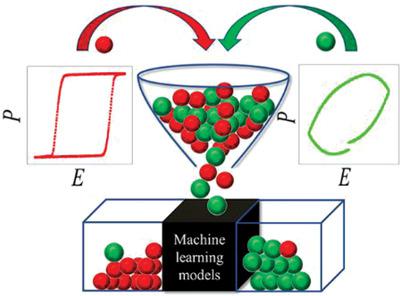当前位置:
X-MOL 学术
›
Adv. Theory Simul.
›
论文详情
Our official English website, www.x-mol.net, welcomes your
feedback! (Note: you will need to create a separate account there.)
Machine Learning Based Distinguishing between Ferroelectric and Non‐Ferroelectric Polarization–Electric Field Hysteresis Loops
Advanced Theory and Simulations ( IF 2.9 ) Pub Date : 2020-07-12 , DOI: 10.1002/adts.202000106 Qicheng Huang 1, 2 , Zhen Fan 1, 2 , Lanqing Hong 3 , Shengliang Cheng 1 , Zhengwei Tan 1 , Guo Tian 1 , Deyang Chen 1 , Zhipeng Hou 1 , Minghui Qin 1 , Min Zeng 1 , Xubing Lu 1 , Guofu Zhou 2, 4 , Xingsen Gao 1 , Jun‐Ming Liu 5
Advanced Theory and Simulations ( IF 2.9 ) Pub Date : 2020-07-12 , DOI: 10.1002/adts.202000106 Qicheng Huang 1, 2 , Zhen Fan 1, 2 , Lanqing Hong 3 , Shengliang Cheng 1 , Zhengwei Tan 1 , Guo Tian 1 , Deyang Chen 1 , Zhipeng Hou 1 , Minghui Qin 1 , Min Zeng 1 , Xubing Lu 1 , Guofu Zhou 2, 4 , Xingsen Gao 1 , Jun‐Ming Liu 5
Affiliation

|
The polarization–electric field (P–E) hysteresis loop is one of the most important criteria for identifying ferroelectricity. However, a P–E loop with apparent hysteresis window can be generated from non‐ferroelectric sources such as leakage current. So far distinguishing between ferroelectric and non‐ferroelectric loops is still performed in a manual way, which can be error prone and time consuming, particularly when the loops are not easily distinguishable and the number of loops to be identified is large. Here, two machine learning (ML) approaches are developed, one using the polarization values along the P–E loops as the input dataset (termed as “value‐based” approach) and the other using the loop images as the input dataset (termed as “image‐based” approach), to identify the P–E loops as ferroelectric or non‐ferroelectric. The value‐ and image‐based ML approaches achieve identification accuracies as high as 93.08% and 87.42%, respectively. In addition, it is tested that both approaches complete an identification of about 160 loops in very short time (≈1.0 s). The high accuracy and efficiency therefore demonstrate that the ML approaches significantly outperform the manual way for distinguishing ferroelectric from non‐ferroelectric P–E loops, which may greatly facilitate the research on ferroelectrics.
中文翻译:

基于机器学习的铁电和非铁电极化-电场磁滞回线的判别
的极化-电场(P - ë)磁滞回线是用于识别铁电的最重要的标准之一。但是,可以从诸如漏电流之类的非铁电源产生具有明显滞后窗口的P–E回路。到目前为止,铁电回路和非铁电回路的区分仍然是手动进行的,这容易出错且耗时,尤其是当回路不易区分且要识别的回路数量较大时。在这里,开发了两种机器学习(ML)方法,一种使用沿P–E的极化值循环作为输入数据集(称为“基于值”的方法),另一个使用回路图像作为输入数据集(称为“基于图像的”方法),以将PE回路标识为铁电或非铁电。基于价值和基于图像的机器学习方法分别实现了高达93.08%和87.42%的识别精度。此外,还测试了这两种方法都可以在非常短的时间内(约1.0 s)完成对约160个回路的识别。因此,高精度和高效率证明了ML方法明显优于手动方法来区分铁电与非铁电PE回路,这可能极大地促进了铁电学的研究。
更新日期:2020-07-12
中文翻译:

基于机器学习的铁电和非铁电极化-电场磁滞回线的判别
的极化-电场(P - ë)磁滞回线是用于识别铁电的最重要的标准之一。但是,可以从诸如漏电流之类的非铁电源产生具有明显滞后窗口的P–E回路。到目前为止,铁电回路和非铁电回路的区分仍然是手动进行的,这容易出错且耗时,尤其是当回路不易区分且要识别的回路数量较大时。在这里,开发了两种机器学习(ML)方法,一种使用沿P–E的极化值循环作为输入数据集(称为“基于值”的方法),另一个使用回路图像作为输入数据集(称为“基于图像的”方法),以将PE回路标识为铁电或非铁电。基于价值和基于图像的机器学习方法分别实现了高达93.08%和87.42%的识别精度。此外,还测试了这两种方法都可以在非常短的时间内(约1.0 s)完成对约160个回路的识别。因此,高精度和高效率证明了ML方法明显优于手动方法来区分铁电与非铁电PE回路,这可能极大地促进了铁电学的研究。











































 京公网安备 11010802027423号
京公网安备 11010802027423号